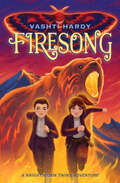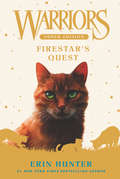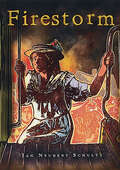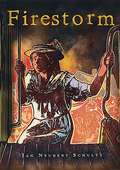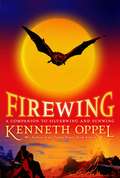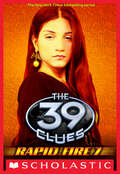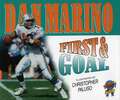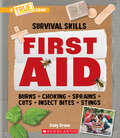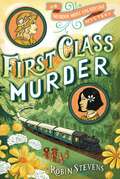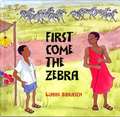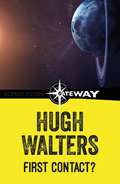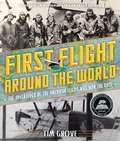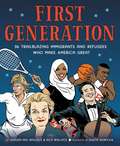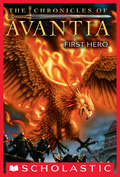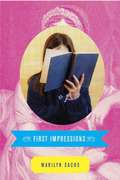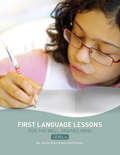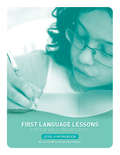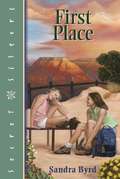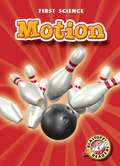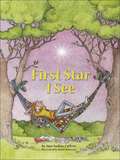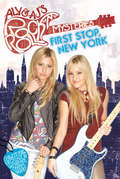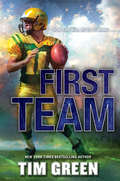- Table View
- List View
Firesong: A Brightstorm Adventure (Brightstorm Twins #3)
by Vashti HardyIn this spirited third Brightstorm adventure, the twins journey north to protect the legendary earth-bear and to discover their family’s hidden history. Arthur and Maudie Brightstorm are back home in Lontown and finally settling in after their exhilarating—and secret—adventures in Erythea. Maudie’s sky-ak invention is a hit, and Harriet has just announced that she will share her sky-ship’s hydroelectric technology. But tensions are brewing. Pitch is becoming more and more difficult to mine, and the existence of super-sapient creatures on other continents threatens how the Explorers see themselves in the natural order of the world. When Arthur and Maudie begin hearing a strange song summoning them north—a song only they can hear—they know there’s an adventure waiting for them that may change the lives of everyone in the Wide. As the crew of the Aurora prepares for their trip, they’re joined by new members and old friends. But they’re not the only sky-ship journeying northward to uncover the region’s secrets. . . . Return to Vashti Hardy’s “marvelously imagined” world (Publisher's Weekly) in this sweeping and propulsive new addition to the Brightstorm series.
Firestar's Quest (Warriors Super Edition #1)
by Erin HunterThere is peace at last between the warrior Clans, and all four are thriving. Then Firestar, legendary leader of ThunderClan, discovers a shocking secret: StarClan, the warrior ancestors who guide his paw steps, have lied to him. Firestar must embark on a perilous quest to discover a long-forgotten truth. Whatever he finds at the end of his journey, he's sure of one thing: Nothing will ever be the same again.
Firestorm (Adventures In Time Ser.)
by Janet Neubert SchultzIt's September 1, 1894, and 13-year-old Maggie Grant and her family are about to face a terror like none they've ever experienced. Having recently moved to the newly constructed town of Hinckley, Minnesota, they are caught in the path of one of the deadliest forest fires in history. Separated from her brothers and forced to flee, Maggie begins a harrowing train ride to Duluth, Minnesota, as the fire rages around her. Once there, Maggie must make a choice--should she stay in Duluth, or can she face her fears and return to what remains of Hinckley to search for her brothers?
Firestorm (Adventures In Time Ser.)
by Janet Neubert SchultzIt's September 1, 1894, and 13-year-old Maggie Grant and her family are about to face a terror like none they've ever experienced. Having recently moved to the newly constructed town of Hinckley, Minnesota, they are caught in the path of one of the deadliest forest fires in history. Separated from her brothers and forced to flee, Maggie begins a harrowing train ride to Duluth, Minnesota, as the fire rages around her. Once there, Maggie must make a choice--should she stay in Duluth, or can she face her fears and return to what remains of Hinckley to search for her brothers?
Fireweed
by Jill Paton WalshTwo teenage runaways who refuse to be evacuated from London struggle for survival amid the 1940 Blitz.
Firewing
by Kenneth OppelThe forest heaves and splits in a terrible quake, and Griffin, a newborn Silverwing bat, is sucked down a fissure deep into the earth. Shade, Griffin's father, soon realizes that his son has been drawn into the Underworld and embarks on the most dangerous of journeys to rescue him. Shade knows he must find Griffin quickly -- legend says that if the living stumble into the land of the dead, they have only a short time before death claims them, too. But something else is hunting Griffin -- a deadly foe Shade hoped he would never see again. Who will find Griffin first?
Fireworks (The 39 Clues: Rapid Fire #7)
by Clifford RileyThe last of seven brand new 39 Clues stories with an explosive secret revealed! The holidays can be hard for any family but they're particularly tough for the Cahills. Amy Cahill is exhausted from her training. Dan can't forget the tragedies he witnessed on the Clue hunt. Ian and Natalie Kabra are trying to enjoy the London festivities but it's hard without their parents. Even superstar Jonah Wizard is having trouble getting into the holiday spirit. Amy knows there's danger on the horizon but there's no reason they shouldn't enjoy themselves while they can. Taking advantage of their new fortune Amy and Dan book a private plane and jet off to fetch the other Cahills for a New Years none of them will ever forget.
First & Goal
by Dan MarinoIn words, photos and entertaining illustrations, record-setting Miami Dolphin quarterback Dan Marino describes his early childhood in Pittsburgh, his successes and failures in high school and college sports, and his remarkable professional career. Marino discusses the need to always strive for perfection, no matter the setbacks and obstacles discovered along the way.
First Aid (A True Book (Relaunch))
by Cody CraneLearn basic survival skills and connect with nature!Knowing how to treat injuries is a skill that every outdoor adventurer needs. Did you know that you can splint a broken finger using only tape? Or that cool water is the first step to treating a burn? Learn all this and more in First Aid—a book that gives kids the confidence they need to get outside and explore.ABOUT THE SERIES: Learning basic survival skills will give every kid the confidence—and the know-how—to handle emergencies and extreme situations. It also helps them feel comfortable and secure when they’re connecting with the outdoors while hiking, backpacking or simply exploring the woods. The books in the Survival Skills series teach kids how to build a shelter from found materials, how to navigate—even without a compass,—how to treat injuries in case of emergency, and so much more. These essential skills will give them the tools to take care of themselves in any situation.
First Boy
by Gary SchmidtGary Schmidt's First Boy fast-paced political thriller will have the reader turning the pages in anticipation of the next clue."You're my first boy, Cooper, my first boy," grandfather says just before he dies. All alone in the world, without even a dog, the only thing that keeps Cooper going is running the dairy farm.Suddenly, black sedans are swarming all around Cooper's small New Hampshire town, driven by mysterious men in dark suits. Cooper's barn is burned to the ground, and his house is broken into and searched during the night. The President of the United States calls on Cooper for a visit, and her opponent wants Cooper to join him on the campaign trail. Who exactly is Cooper Jewett, and what does the government want with him?
First Class Murder: Murder Is Bad Manners; Poison Is Not Polite; First Class Murder; Jolly Foul Play; Mistletoe And Murder (A Murder Most Unladylike Mystery)
by Robin StevensA murdered heiress, a missing necklace, and a train full of shifty, unusual, and suspicious characters leaves Daisy and Hazel with a new mystery to solve in this third novel of the Wells & Wong Mystery series.Hazel Wong and Daisy Wells are taking a vacation across Europe on world-famous passenger train, the Orient Express—and it’s clear that each of their fellow first-class travelers has something to hide. Even more intriguing: There’s rumor of a spy in their midst. Then, during dinner, a bloodcurdling scream comes from inside one of the cabins. When the door is broken down, a passenger is found murdered—her stunning ruby necklace gone. But the killer has vanished, as if into thin air. The Wells & Wong Detective Society is ready to crack the case—but this time, they’ve got competition.
First Come The Zebra
by Lynne BaraschWhen Abaani, a Maasai boy, takes his family's cattle out to graze, he is suprised to see a Kikuyu boy, Haki, tending a new fruit and vegetable stall alongside the road. Aware of the traditional conflict between the Maasai and the Kikuyu, the boys take an immediate dislike to each other. A short while later, as customers surround Haki's stall, a dangerous situation arises - and as the boys act together to confront the danger, they also take the first step in overcoming their differences and becoming friends.
First Contact
by Hugh WaltersMysterious radio signals were being received from the planet Uranus, and Earth's leading scientists decided that a complete investigation was needed. For the first time, the U.N.E.X.A. planned a two-ship expedition, under the overall command of Chris Godfrey. Serge, Morrey and Tony were of course included, and four other astronauts made up the crew of the two ships.At first the signals made little difference to them, except that they produced violent headaches if listened to for more than a few seconds. But when Chris awoke after a spell of hypothermia and tried to call the other ship he was horrified to hear the sinister sounds from Uranus on the wavelength which connected the two ships with each other and both of them with Control, back on Earth...
First Flight Around The World: The Adventures Of The American Fliers Who Won The Race
by Tim GroveA 2016 YALSA Award for Excellence in Nonfiction for Young Adults Finalist<P><P> In 1924 the U.S. Army sent eight young men on a bold attempt to be the first to circumnavigate the globe by flight. Men from five other countries—Great Britain, France, Portugal, Italy, and Argentina—had the same goal. The race was on!<P> First Flight Around the World documents the exciting journey of four American planes—the Chicago, Boston, New Orleans, and Seattle—and their crews on a race around the world. The trip held many challenges: extreme weather, tricky navigation, unfamiliar cultures, fragile planes, and few airfields. The world fliers risked their lives for the sake of national pride.<P> Based in part on the journal of one of the crew members, First Lieutenant Leslie Arnold, along with commentary, newspaper reports, and archival images, First Flight Around the World is a captivating tale about American ingenuity, gumption, and perseverance.
First Generation: 36 Trailblazing Immigrants and Refugees Who Make America Great
by Rich Wallace Sandra Neil Wallace Agata NowickaCelebrate the genius, diversity, and grit of immigrants and refugees in this boldly illustrated guide to 36 American trailblazers.The men and women in this book represent nations from Somalia to Germany, from Syria to China, from Mexico to Sweden, and more. They are people like Secretary of State Madeleine Albright, international singing sensation Celia Cruz, star basketball player Dikembe Mutombo, world-renowned physicist Albert Einstein, and influential journalist Jorge Ramos. And they are all immigrants or refugees to the United States of America. Their courage, their achievements, and their determination to change the world have helped make our country a stronger place. Perhaps after reading their stories, you will be inspired to make the world a better place, too.
First Hero: First Hero (The Chronicles of Avantia #1)
by Adam BladeDeadly Beasts. Brutal combat. Welcome to Avantia.At the age of seven, Tanner's father was killed in front of him by the evil warlord Derthsin. But his father's death was not in vain and Derthsin was carried away to his doom by a good Beast, Firepos the Flame Bird. Now, eight years later, another evil army is wreaking havoc across Avantia. But Tanner has been training with Firepos, waiting to avenge his father's death. There is something familiar about this new menace, who rides with a Beast of his own. The evil army is after the pieces of the Mask of Death--which allows whoever wears it to control all Beasts. Tanner sets off on a journey to stop them. Along the way, he encouters twins Gwen and Geffen, who hold the map to finding the remaining pieces.
First Impressions
by Marilyn Sachs" I read on. And then it happens. On page 89. Mary is humiliated, and I know I have to step in. There she is, in an ill-fitting, wine-colored gown that doesn't do anything for her mousy complexion, gathering up her music, when I pass by, and spill my glass of punch right on her dress. I turn, and there is Kevin, dressed in a scarlet coat and all the rest of the uniform of a British Soldier, circa 1811. 'What are you doing here?' I ask. 'Well, this is the part I'm up to in the book.'"The smart middle child in a blue-collar family identifies with Mary, the middle child in Jane Austen's Pride and Prejudice. When Alice enters Mary's world and makes changes in both their lives, she learns that first impressions aren't always right.
First Language Lessons for the Well-Trained Mind: Level 4 Instructor Guide (First Language Lessons)
by Sara Buffington Jessie WiseA simple-to-use, scripted guide to grammar and composition that makes successful teaching easy--for both parents and students. This volume, the Level 4 Instructor Guide in the complete elementary grammar series, uses classical techniques of memorization, dictation, and narration to develop your child's language ability in the important, foundational years of language study. The text covers a full range of grammar topics, including parts of speech, punctuation, sentence diagrams, and skills in beginning writing and storytelling. Optional end units provide practice in dictionary use and letter writing. Designed to follow Levels 1-3, the Level 4 Instructor Guide can also be used as a first grammar text for older students. A Level 4 Student Workbook is available separately with worksheet and activities. Grade Recommendation: Grades 4-5.
First Language Lessons for the Well-Trained Mind: Level 4 Student Workbook (First Language Lessons)
by Sara Buffington Jessie WiseA simple-to-use, scripted workbook to grammar and composition that accompanies the First Language Lessons for the Well-Trained Mind, Level 4 textbook and makes successful teaching easy--for both parents and students. This workbook, accompanying the Level 4 Instructor Guide (available separately) in the First Language Lessons complete elementary grammar series, uses classical techniques of memorization, dictation, and narration to develop your child's language ability in the important, foundational years of language study. This Level 4 Student Workbook provides complete worksheets for the student, making it possible for busy parents and teachers to spend more time teaching and less time preparing. Grade Recommendation: Grades 4-5.
First Meet (The Gymnasts #2)
by Elizabeth A. Levy(Back Cover) The first meet's going to be exciting... but it isn't going to be easy. It's the Pinecones very first meet - and they're competing against the Atomic Amazons. That team is tough! It's a real challenge for all the gymnasts, especially Cindi. She'll have to perform a very difficult move on the uneven bars - the Eagle. It's not enough to do it right - she'll have to do it with a style all her own. Cindi wonders if she can meet the challenge, for herself and for the team.
First Place (Secret Sisters Book #9)
by Sandra ByrdWill the Rim-to-Rim hike make Tess a hero -- or a big-time loser? The Secret Sisters are minding their own business at a Little League game when the snooty Coronado Club stirs up trouble -- again! Tess and her friends have earned the best cabin at Outdoor School -- the one that Lauren and her gang wanted -- and now they're out for revenge. Erin blurts out that Tess is racing across the Grand Canyon Rim-to-Rim with her dad and certainly will win first place. Lauren insists Tess won't make it. Even worse, Lauren makes sure the whole sixth grade will hear all about the race at the Outdoor School's opening-night campfire! Tess is left worrying in silence, not wanting to share the secret that she knows could lead to disaster and embarrassment.
First Science: Motion (Blastoff! Readers)
by Kay ManolisSimple text and full-color photographs introduce beginning readers to motion. Intended for students in grades three through six.
First Star I See
by Lynne Adamson Jaye Andras CaffreyA lively, enchanting story that wonderfully captures the daily ups and downs of being a child with attention deficit disorder through the adventures of Paige, a bright young girl whose inability to stay focused threatens to spoil her best efforts to win a school contest.
First Stop, New York (Aly & Aj's Rock 'n' Roll Mystery #1)
by Tracey West Katherine NollAly & AJ prepare to take the country by storm! The first stop on their tour is New York City. Before their performance, Aly & AJ visit the brand-new Girls Rock Academy, a school for girls who love rock `n' roll. The day before the grand opening, all the school''s equipment is stolen! Can Aly & AJ solve the mystery of the missing guitars in time for the school''s opening?
First Team
by Tim GreenBrock is on the run again in New York Times bestselling author Tim Green's companion book to New Kid. Perfect for fans of Mike Lupica or Dan Gutman's Baseball Card Adventure series. <P><P>With his strong left arm, Brock knows he can be a great quarterback, and with the help of his new friend, Mak, he has a plan to make the first team. But the coaches have plans of their own, especially for the kids from the wrong side of the tracks, which is exactly where Brock now lives. <P><P>As Brock is trying to fit in, his father's past is catching up to him--and one chance meeting causes everything to come crashing down. Will Brock finally be able to navigate his new life, or will his past force him back on the run?
